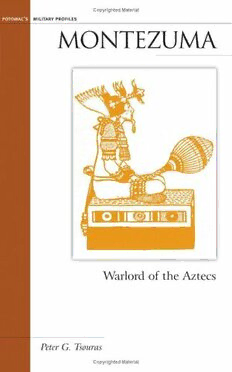
Montezuma: Warlord of the Aztecs (Potomac Books' Military Profiles) PDF
145 Pages·2005·0.856 MB·English
Most books are stored in the elastic cloud where traffic is expensive. For this reason, we have a limit on daily download.
Preview Montezuma: Warlord of the Aztecs (Potomac Books' Military Profiles)
Description:
Places Aztec civilization and history in the context of world history Montezuma (ca. 1466–1520), who had been educated as a priest and had served well as a military commander, ascended to the Aztec throne in about 1502 on the basis of his military record and reputation for piety. As Peter G. Tsouras demonstrates, almost immediately Montezuma transformed himself from a man of good judgment to a pitiless autocrat. He killed indiscriminately at home and waged wars of conquest against his neighbors, adding territory in contemporary Honduras and Nicaragua to his empire. In 1519, Hernán Cortés arrived in Mexico at the head of a Spanish expedition. Montezuma believed the invaders to be gods fulfilling the prophecy that the god Quetzalcoatl would return. He failed to resist and cautiously offered gifts. As a result, Cortés and the conquistadors marched on the capital and seized Montezuma. The monarch fell, surrendering his power, wealth, and even the sovereignty of his people, almost gladly. He became a puppet of the Spaniards and finally allied himself in battle against his own people. When the emperor’s brother at last led an uprising, the ungrateful Spaniards killed Montezuma. Against the backdrop of ancient Mexico’s rich cultural heritage, Tsouras captures the tragedy that befell Mexico during Montezuma’s reign.
See more
The list of books you might like
Most books are stored in the elastic cloud where traffic is expensive. For this reason, we have a limit on daily download.
